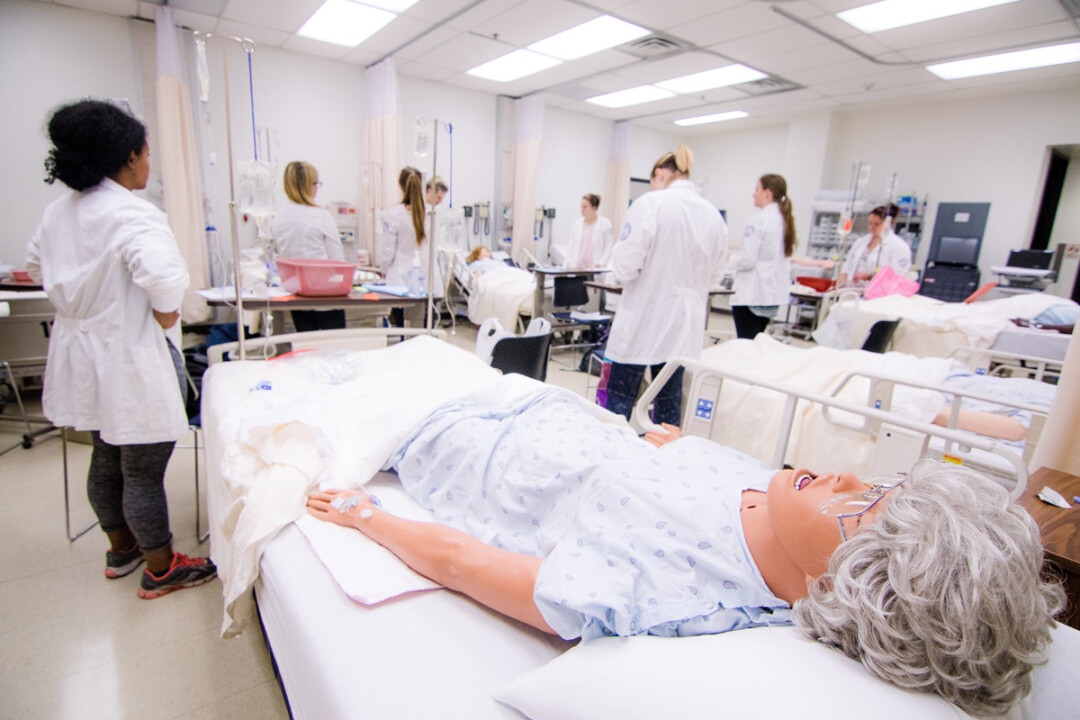They're Alive ... Almost
simulation lab gives UWEC students lifelike nursing practice
Barbara Arnold, photos by Andrea Paulseth |

Tucked away on the second floor of the College of Nursing and Health Sciences building at UW-Eau Claire is the Skills and Simulation Lab, a place where dozens of UWEC nursing students get valuable hands-on training with manikin simulators that look and react like real patients. Before even interacting with living, breathing patients in a clinical setting, students hone their skills here.
“Once you get over the initial … shock of how realistic the manikins are, being able to experience the reactions and sounds they are capable of is truly very helpful.” – Stephanie Hurst, UW-Eau Claire nursing student
In a series of combined rooms that measure 2,452 square feet, there are three hospital-style wards with six to seven beds each, and each contains adult manikin simulators of various types, races, and sexes. Then there are the specialized rooms: a birthing room for moms and infants, which includes an open warmer in which a newborn is placed for assessment after birth, and a pediatrics room especially for children. In addition, another suite resembles two single hospital rooms for adult patients. Outside the specialized rooms are consoles at which nursing professors and instructors can facilitate programmed and on-the-fly scenarios so students can practice and be evaluated on identifying, assessing, and implementing interventions in a variety of patient situations and settings.
The objective of all this is to create a realistic environment that allows for experiential learning, according to Nita Johnson, MSN, RN, the Skills and Simulation Lab’s coordinator and a clinical instructor. Johnson started at UWEC in 1994 and since then, along with other colleagues, has built up the Skills and Simulation Lab into what it is today.
The manikins, which look lifelike, range from low-fidelity (anatomically correct models) to medium-fidelity (which are more active and may have programmable pulses, breath, and heart sounds) to high-fidelity (which are reactive and interactive, making them even more similar to real human beings).
“Fidelity in simulation is the degree to which realism is achieved,” explains Johnson. “The use of the manikins allows the students to engage in problem-solving, practice assessment, (and) psychomotor and communication skills to promote mastery and build confidence.” (See sidebar below).
UWEC is currently educating about 340 nursing students a year: 260 in the traditional undergraduate nursing program in Eau Claire and another 80 students at its distance education site in Marshfield, according to Deb Jansen, associate dean of the university’s College of Nursing and Health Sciences.
This past summer, Stephanie Hurst, a senior nursing student, shared her experiences in the Skills and Simulation Lab with an aunt who recently retired from nursing.

“My aunt could not believe that we had manikins that replicate real patient interactions, such as talking, blinking, and even sweating,” Hurst says. “Once I told her that there were manikins that were able to actually give birth, she was floored.
“Once you get over the initial … shock of how realistic the manikins are, being able to experience the reactions and sounds they are capable of is truly very helpful,” she continues. “For example, being able to use my stethoscope and listen to a manikin’s chest and hear crackles and wheezing prior to assessing whether or not the tracheostomy needs to be suctioned out during a simulation really plays into using all of your senses to make critical nursing judgments.
“Once I graduate and am thrown into the real world of nursing, I believe that the Simulation Lab will have not only allowed me to practice skills that I will use as a nurse but also stresses the importance of knowing proper technique before doing any intervention,” she concludes. “It is so critical to be aware of correct and incorrect ways to do procedures in order to maintain a culture of safety not only for the patients but also your colleagues and yourself.”
According to Kyle Kackman, a nursing student who will graduate in December, the Skills and Simulation Lab provides students with medical supplies that can commonly be found in a hospital. “These supplies are used to perform nursing skills that eventually we will need to complete when we become registered nurses,” he shares. “Once I am working as a professional nurse, I know the training in this lab has prepared me to identify critical situations and how to deal with them appropriately.”
Emily Dohms, RN, who graduated from the UWEC nursing program in spring 2009, is a registered nurse on the neuro/pediatric/trauma unit at Mayo Clinic Health System in Eau Claire. “The Skills and Simulation Lab enabled me to take book knowledge and apply it at the bedside,” she says. “We became acquainted with the basics of nursing care, including head-to-toe assessments, checking vital signs, and something so simple as pulling curtains back to ensure privacy for our patient manikins, for example.
“As we expanded our knowledge base, our skills got more technical,” she continues. “So we learned how to perform urinary catheterization on male and female parts, in-line suctioning for tracheostomy patients, and wound dressing changes, among others.”
Johnson emphasized that the simulations used in the UWEC College of Nursing and Health Sciences Skills and Simulation Lab are an extremely powerful teaching tool. Students can carry the lessons learned there into the real world after they graduate.
All three Blugolds in nursing agreed, and Hurst summed it up this way: “Being a UW-Eau Claire student nurse is not easy, but it is definitely worth it in every way. The learning experiences I’ve been in, particularly in the Skills and Simulation Lab, and connections I’ve made with other students and faculty, are without a doubt, priceless.”
Simulated Situations
Nita Johnson, MSN, RN, Skills and Simulation Lab coordinator and clinical instructor at the UW-Eau Claire College of Nursing and Health Sciences, described the different types of manikins nursing students use to learn procedures and assess their knowledge, skills, and abilities in nursing prior to doing their clinical studies.
Low-Fidelity Manikins: Full body of an adult, child, or infant that is anatomically correct. They have interchangeable parts for gender and wounds or surgical care.
Medium-Fidelity Manikins: Same as above with some electronic (computer driven) responses or interactions (beating pulses, breath, bowel, and cardiac sounds, vocal sounds) which can be programmed.
High-Fidelity Manikins: Same as above with the capability of emitting body fluids (urine, tears, sweat, saliva) and allow administration of IV fluids and medications. Highly sophisticated for practice of advanced nursing and medical interventions and assessments. With programming, they are able to respond automatically to procedures and treatments.






















